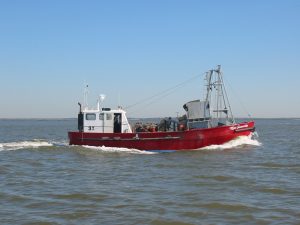About
Education
Ph.D. 1994 Rutgers, The State University of New Jersey
M.S. 1987 University of Houston
B.S. 1984 The Ohio State University
Research Interests
The predominant thrust of my research concerns host-parasite interactions in bivalve molluscs. In this area I oversee the HSRL Histopathology Laboratory that provides diagnostic services for research, shellfish management and the shellfish industry. A major active initiative is the Regional Shellfish Seed Biosecurity Program (RSSBP). A second research focus aims to enhance our understanding of the ecological impact of bivalves, particularly the eastern oyster, at the population, community and ecosystem levels. My lab works regularly and proactively with the state of New Jersey and the shellfish industry to improve management and efficiency of shellfishing and shellfish aquaculture as these activities interact with the ecosystem in which they exist. In the face of rising seas and resulting shoreline erosion, this broader perspective has led us to investigate the role shellfish can play in “nature-based solutions” for combating climate change, eutrophication and other major problems.
 Many bivalves and other molluscan shellfish support important commercial fisheries or are commercially farmed and harvested for various forms of exploitation (e.g., food, medicine, jewelry). The natural populations of many species have declined dramatically due to decades, even centuries, of over fishing and habitat loss/degradation. Today, most of these species continue to face high fishing pressure and habitat loss. In addition, many also face increasing levels of parasitism and disease. Aquaculture has and continues to relieve some of the pressure on natural populations, but has its own set of environmental impacts, positive and negative. Yet, parasites and disease plague many aquaculture and restoration efforts. Understanding host-parasite dynamics and disease processes at all levels (molecular, cellular, organism, population, community, and ecosystem) is crucial to the development of successful management strategies. Bivalves and their parasites do not exist in a vacuum, but within a complex ecosystem.
Many bivalves and other molluscan shellfish support important commercial fisheries or are commercially farmed and harvested for various forms of exploitation (e.g., food, medicine, jewelry). The natural populations of many species have declined dramatically due to decades, even centuries, of over fishing and habitat loss/degradation. Today, most of these species continue to face high fishing pressure and habitat loss. In addition, many also face increasing levels of parasitism and disease. Aquaculture has and continues to relieve some of the pressure on natural populations, but has its own set of environmental impacts, positive and negative. Yet, parasites and disease plague many aquaculture and restoration efforts. Understanding host-parasite dynamics and disease processes at all levels (molecular, cellular, organism, population, community, and ecosystem) is crucial to the development of successful management strategies. Bivalves and their parasites do not exist in a vacuum, but within a complex ecosystem.
 Bivalve molluscs often serve prominent roles in the ecology of estuarine and coastal ecosystems. For example, the eastern oyster (Crassostrea virginica) is a reef-forming, filter feeding bivalve that lives in estuaries along the east and gulf coasts of North America. Oyster reefs perform a variety of ecological roles that contribute significantly to the structure and function of the coastal ecosystems in which they exist. They form a unique habitat that supports an abundance of taxonomically diverse species. They stabilize banks and bottom sediments and serve as both active and passive filters as waters pass over them. Moreover, the metabolic activity of the oysters and other organisms associated with the reefs actively couple benthic and pelagic communities. In a broad sense, the ecological role of oyster reefs is gaining appreciation, but much remains to be learned.
Bivalve molluscs often serve prominent roles in the ecology of estuarine and coastal ecosystems. For example, the eastern oyster (Crassostrea virginica) is a reef-forming, filter feeding bivalve that lives in estuaries along the east and gulf coasts of North America. Oyster reefs perform a variety of ecological roles that contribute significantly to the structure and function of the coastal ecosystems in which they exist. They form a unique habitat that supports an abundance of taxonomically diverse species. They stabilize banks and bottom sediments and serve as both active and passive filters as waters pass over them. Moreover, the metabolic activity of the oysters and other organisms associated with the reefs actively couple benthic and pelagic communities. In a broad sense, the ecological role of oyster reefs is gaining appreciation, but much remains to be learned.